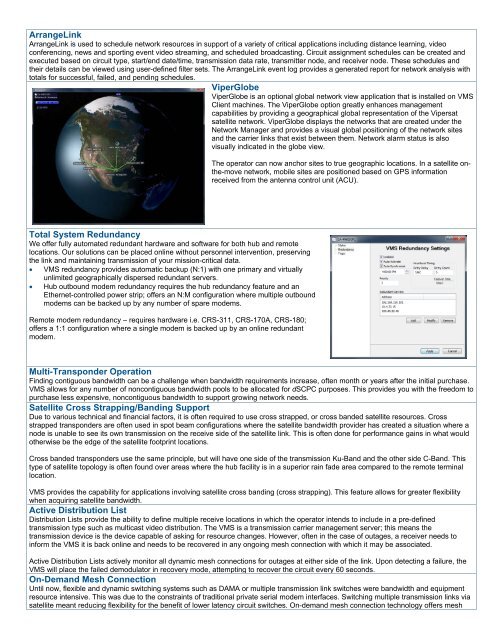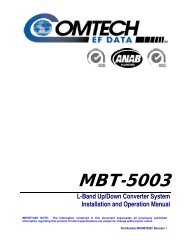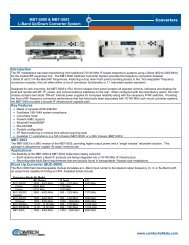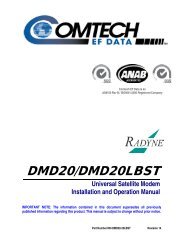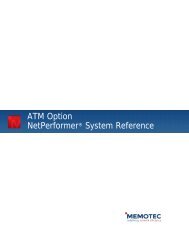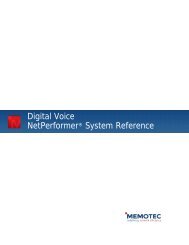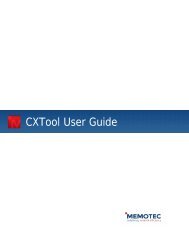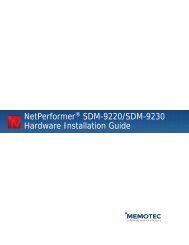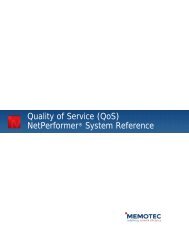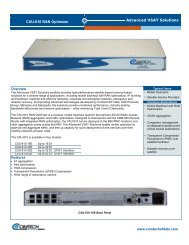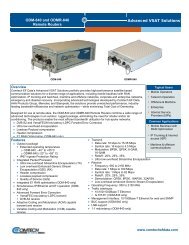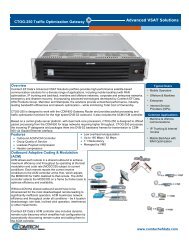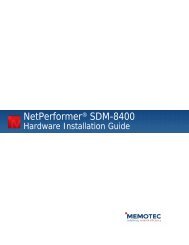VMS - Comtech EF Data
VMS - Comtech EF Data
VMS - Comtech EF Data
You also want an ePaper? Increase the reach of your titles
YUMPU automatically turns print PDFs into web optimized ePapers that Google loves.
ArrangeLink<br />
ArrangeLink is used to schedule network resources in support of a variety of critical applications including distance learning, video<br />
conferencing, news and sporting event video streaming, and scheduled broadcasting. Circuit assignment schedules can be created and<br />
executed based on circuit type, start/end date/time, transmission data rate, transmitter node, and receiver node. These schedules and<br />
their details can be viewed using user-defined filter sets. The ArrangeLink event log provides a generated report for network analysis with<br />
totals for successful, failed, and pending schedules.<br />
ViperGlobe<br />
ViperGlobe is an optional global network view application that is installed on <strong>VMS</strong><br />
Client machines. The ViperGlobe option greatly enhances management<br />
capabilities by providing a geographical global representation of the Vipersat<br />
satellite network. ViperGlobe displays the networks that are created under the<br />
Network Manager and provides a visual global positioning of the network sites<br />
and the carrier links that exist between them. Network alarm status is also<br />
visually indicated in the globe view.<br />
Total System Redundancy<br />
We offer fully automated redundant hardware and software for both hub and remote<br />
locations. Our solutions can be placed online without personnel intervention, preserving<br />
the link and maintaining transmission of your mission-critical data.<br />
� <strong>VMS</strong> redundancy provides automatic backup (N:1) with one primary and virtually<br />
unlimited geographically dispersed redundant servers.<br />
� Hub outbound modem redundancy requires the hub redundancy feature and an<br />
Ethernet-controlled power strip; offers an N:M configuration where multiple outbound<br />
modems can be backed up by any number of spare modems.<br />
Remote modem redundancy – requires hardware i.e. CRS-311, CRS-170A, CRS-180;<br />
offers a 1:1 configuration where a single modem is backed up by an online redundant<br />
modem.<br />
The operator can now anchor sites to true geographic locations. In a satellite onthe-move<br />
network, mobile sites are positioned based on GPS information<br />
received from the antenna control unit (ACU).<br />
Multi-Transponder Operation<br />
Finding contiguous bandwidth can be a challenge when bandwidth requirements increase, often month or years after the initial purchase.<br />
<strong>VMS</strong> allows for any number of noncontiguous bandwidth pools to be allocated for dSCPC purposes. This provides you with the freedom to<br />
purchase less expensive, noncontiguous bandwidth to support growing network needs.<br />
Satellite Cross Strapping/Banding Support<br />
Due to various technical and financial factors, it is often required to use cross strapped, or cross banded satellite resources. Cross<br />
strapped transponders are often used in spot beam configurations where the satellite bandwidth provider has created a situation where a<br />
node is unable to see its own transmission on the receive side of the satellite link. This is often done for performance gains in what would<br />
otherwise be the edge of the satellite footprint locations.<br />
Cross banded transponders use the same principle, but will have one side of the transmission Ku-Band and the other side C-Band. This<br />
type of satellite topology is often found over areas where the hub facility is in a superior rain fade area compared to the remote terminal<br />
location.<br />
<strong>VMS</strong> provides the capability for applications involving satellite cross banding (cross strapping). This feature allows for greater flexibility<br />
when acquiring satellite bandwidth.<br />
Active Distribution List<br />
Distribution Lists provide the ability to define multiple receive locations in which the operator intends to include in a pre-defined<br />
transmission type such as multicast video distribution. The <strong>VMS</strong> is a transmission carrier management server; this means the<br />
transmission device is the device capable of asking for resource changes. However, often in the case of outages, a receiver needs to<br />
inform the <strong>VMS</strong> it is back online and needs to be recovered in any ongoing mesh connection with which it may be associated.<br />
Active Distribution Lists actively monitor all dynamic mesh connections for outages at either side of the link. Upon detecting a failure, the<br />
<strong>VMS</strong> will place the failed demodulator in recovery mode, attempting to recover the circuit every 60 seconds.<br />
On-Demand Mesh Connection<br />
Until now, flexible and dynamic switching systems such as DAMA or multiple transmission link switches were bandwidth and equipment<br />
resource intensive. This was due to the constraints of traditional private serial modem interfaces. Switching multiple transmission links via<br />
satellite meant reducing flexibility for the benefit of lower latency circuit switches. On-demand mesh connection technology offers mesh


